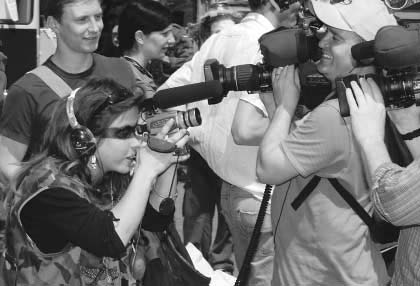News
In May 2014 Rebelact will organise a serie of info nights about the present situation in Egypt. Maro, a female Egyptian activist and rebel clown, will give lectures on the recent developments... More
Get Involved
Extra Info
The Clandestine Insurgent Rebel Clown Army goes to Scotland via a few other places
…the clowns are organising… the clowns are organising – over and out…
Overheard on police radio, July 4 2004 action against Menwith Hill spy base, UK
PLAYING GAMES WITH AUTHORITY
Clowns always speak of the same thing, they speak of hunger; hunger for food, hunger for sex, but also hunger for dignity, hunger for identity, hunger for power. In fact, they introduce questions about who commands, who protests.
Dario Fo, Italian political playwright/fool
The early morning radio reports traffic disruption across central Scotland. ‘Avoid the area if you can’, says the presenter as she lists dozens of roads and railway lines that have been blocked by protesters during the opening of the G8 summit. Fresh from a little jaunt on the A9 motorway involving 60 rebel clowns in military uniforms, over 100 policemen in riot gear, several barking police dogs, a few delegates coaches and dozens of bright orange traffic cones, a small gaggle (1) of clowns is making its way to the G8Alternatives march.
They pass over a bridge above the motorway. Half a dozen policemen line up, they face the line of clowns and the two groups stare at each other. A pair of clowns dressed as cops, part of the hilarious Backwards Intelligence Team, (2) start to count down – ‘Five, four, three, two, one – go!’ The (real) police and clowns rush towards each other, their hands outstretched, faces grimacing and screaming ‘Kazamm’. There is a floating moment of confusion and then they run into each other’s open arms – clowns hug cops, cops hug clowns. Everyone is a bit surprised, there is a roar of celebratory cheers from the clowns and slightly sheepish and embarrassed applause from the police.
Somehow, this clown gaggle had managed to persuade the police to play a game with them. Known as ‘Dwarfs, Wizards and Giants’ it’s a version of paper-scissors-stone, but played in teams with the whole body. One of the rules is that if both teams choose the same character, no one wins and they all have to hug. This is exactly what happened as clown and cop teams simultaneously chose to be ‘wizards’.
Perhaps this is not behaviour one would expect from this motley crew of activists who had been ridiculed by Bob Geldof as a bunch of ‘thuggish… losers’ with ‘white painted faces’ come to ‘wreck’ his Live8 events. (3) But in many ways this brief moment on a bridge, less than a mile away from where the G8 were meeting behind their fences patrolled by 15,000 police, could be seen as a beautiful example and illustration of the tactics and theory of rebel clowning. Behind its white-faced facade of stupidity, it is a serious attempt to develop a form of civil disobedience that breaks down the binary and oppositional thinking that is still so inherent within protest movements.
Dichotomies between the personal and the political, the classic us and them, activist and non-activist, violence and non-violence and, of course, protesters and police, seem outmoded ways of thinking in a movement that has been inspired by numerous types of thinking (from post-modern, ecological, late feminism or anarchism) which emphasise processes, continuums, relationships, systems and networks.
Rebel clowns refuse all dichotomies: they are often neither male nor female, neither artist nor activist, neither clever nor stupid, neither mad nor sane, entertainment nor threat. They know that these clear oppositions are oppressive and, more importantly, that if we really are to win this fight for the survival of humanity and the earth’s eco-systems, then one day we will have to convince the cops and soldiers to change sides.
PEELING OFF THE REBEL ARMOUR
…our behaviour is a function of our experience. We act according to the way we see things. If our experience is destroyed, our behaviour will be destructive. If our experience is destroyed we have lost our own selves.
R.D.Laing, The Politics of Experience
The Clandestine Insurgent Rebel Clown Army (CIRCA) was founded in November 2003 to ‘celebrate’ George Bush’s visit to the UK. (4) On the surface it seemed to many that it was just another carnivalesque protest tactic, in the footsteps of Reclaim the Streets and the Pink and Silver Samba bands, adding colour and pleasure to the grey tedium of marches and traditional forms of direct action. (5) In fact, it was meant to be a lot more than a tactic. The methodology of rebel clowning was developed as a way of trying to overcome what we perceived as some of the deeper problems in the way we behave as radicals towards each other, ourselves and our world.
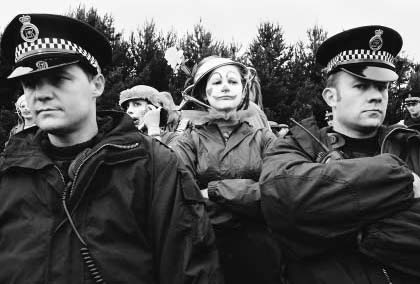
To share and disseminate this form, that we termed ‘rebel clowning’, CIRCA initiated a series of trainings that mixed methodologies from clowning and civil disobedience. The former helps us rediscover an inner playful, childlike state of generosity and spontaneity, while the latter provides us with effective tools of resistance. To join CIRCA it was necessary to take part in a minimum two-day training.
Having worked for many years in direct action movements, we had come to a realisation that more groups and movements are destroyed by poor group dynamics and internal fights than any number of police. (6) The state knows only too well that the best way to disrupt radical groups is by seeding mistrust and conflict amongst them, and letting them destroy themselves. As the state violence in Genoa showed during the G8 meetings in 2001, too much visible police violence creates movement martyrs and bonds between the liberal left and radicals – things which tend to strengthen rather than weaken social movements. Obviously police repression against activists is still rife: mass arrests and beatings are still very much the tragic reality for too many of us, but the ancient ‘divide and rule’ strategy seems to be as active as ever. (7) It is much more effective for the state to play with the cops in our own heads than to batter our heads with truncheons.
Unfortunately radicals are often vulnerable souls. Most of us became politically active because we felt something profoundly, such as injustice or ecological devastation. It is this emotion that triggers a change in our behaviour and gets us politicised. It is our ability to transform our feelings about the world into actions that propels us to radical struggle. But often, what seems to happen is that the more we learn about the issues that concern us, the more images of war we see, the more we experience climate chaos, poverty and the everyday violence of capitalism, the more we seem to harden ourselves from feeling too much. Although feeling can lead to action, we also know that feeling too much can lead to depression and paralysis. Combine this with the stress of repression and criminalisation by the state and many activists begin to grow a thick armour around themselves. Controlling our feelings becomes a mechanism of survival. (8)
Yet in such a controlled state of being, it becomes difficult to be open to others, to listen to oneself and each other. Often we cover up this loss with the illusion of bravery. We become fearless warriors for the planet, often making reckless decisions and putting ourselves or others into dangerous situations. But a warrior who is unable to really feel and perceive what is around her/himself will soon end up dead and ineffective. Fearlessness comes from escaping our bodies, forgetting we are made of flesh and blood and living in the pure abstraction of a mind. By working with the body, rebel clown trainings attempt to peel off this armour (or try to avoid it appearing), to reveal the soft skin again, to find the vulnerable human being who once felt everything deeply and to give them courage – which is about feeling fear and yet deciding to overcome it because your heart tells you it is the right thing to do.
A key aspect of the anti-capitalist direct action movement is our desire for what has been termed ‘prefigurative politics’. A politics that sees no separation between means and ends. To paraphrase Gandhi, we want to be the change we want to see in the world. The eco-village in Stirling, with its permaculture design and horizontal forms of decisionmaking, was a beautiful example of this. Yet our experience has been that despite these inspiring structures, our behaviours, emotional intelligence and relationship to power are sometimes not examples of the world we want to see. Meetings or actions often become cold hostile sites of competitive and even aggressive behaviours and we can be notoriously bad at warmly welcoming strangers into our midst.
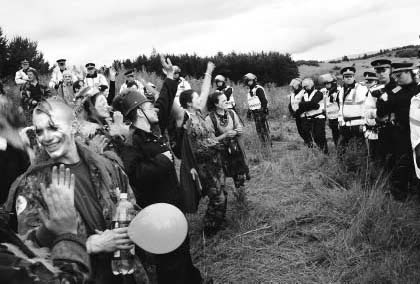
With CIRCA, we wanted to challenge this and find a way to bring the personal back into the centre of radical political action. We wanted to change the way we think and feel as much as the way we fight. For us the psyche, the body and the street should be seen as equally important zones of struggle and areas in need of radical transformation. Simply replacing the structures of society with new ones, without changing our own deeper internal structures, will just repeat the mistakes of so many past revolutions, where the very vision of change we had in the first place was destroyed by the re-establishment of an unfeeling rotten order with the same power structures in place. We don’t want people to adapt to a new established society, rather we want society to adapt to a new person. Mixing the ancient art of clowning with contemporary forms of civil disobedience, we developed a methodology that tries to provide tools for transforming and sustaining the inner emotional life of the activists as well as being an effective technique for taking direct action.
THE STRENGTH OF THE STUPID
… I saw the clown, Pierino, at the fountain … I was moved and admired the poor man dressed as a funny man, whom I realised was a free, amazing being, needing very little to live on and able to survive the most incredible disasters, able to rise from the most frightful calamities, pass unharmed through mockery and contempt and to the very end maintain an unflagging optimism: amused and amusing as only one under heaven’s protection could possibly be.
Federico Fellini, Fellini on Fellini
The clown is a figure whose history can be traced back to some of the earliest forms of performance in the world. Linked to the role of the shaman, the social healer and magician, the clown has in various guises throughout history been someone who was given the liberty to confront all the taboos and truths of a culture, to critique the very core principles of society and yet get away with it. They are able to do this because they inhabit a special place, an in-between space, a weird social no-man’s land. The clown manages to be at the centre and the margins of society simultaneously. S/he is a popular archetype seen everywhere, from the circus to the corporate advert, the public street to the private children’s party, and is recognised for speaking a certain wisdom despite a surface of folly. Yet at the same time, the clown is an outsider, a freak, an object of ridicule. This threshold space that the clown inhabits is powerful. It confuses the categories that the system imposes on us and through her/his eternal mockery, the clown refuses to fall victim to any posturing pride and arrogance.
Clowning is a state of being rather than a technique. At its root, clowning is about letting go, learning to approach every situation with an openness and vulnerability that we all once had as children. It is a state where we begin to value the power of surrendering to experience and living without fixed expectation. It is a state of being that we all grew up with, the state of being that society stamped on and imprisoned in fairgrounds, theatres and circuses. It is the state that learns about the world through play and knows that the difference between imagination and reality is only a matter of opinion.
Like most states it is something that can be developed and taught but this takes an enormous amount of time and effort. It would be naïve to pretend that one can reach such a state of letting go, that one can peel off so many layers of inhibitions, inner fears and conditioning that capitalism teaches us in so many insidious ways throughout our lives in a two-day training. Moreover the concept of the need for ‘training’ is sometimes seen as authoritarian within the movements, and there are people who feel that they can just put on white face paint and a wig, act stupidly and join the ranks of CIRCA. In this we see a potential issue.
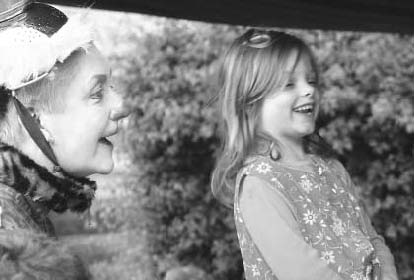
Many of us probably remember seeing an incredible clown, perhaps it was Charlie Chaplin, or Harpo Marx. Their stupidity comes from a deep place of dignity and of doing very little. They don’t pretend to be clowns, they don’t act, they just are themselves and this ability to do very little and yet say so much is something that doesn’t come with a costume, but a radically reformed mind and body: a lifetime’s work. We can all recognise a mediocre clown, one that makes us cringe with embarrassment, such as the kids’ party clown, or the kitsch corporate event clown who is unable to make us laugh however much s/he tries and is certainly unable to make us contemplate profound social truths. An army of incredible clowns is what we dreamt about for CIRCA, and perhaps in its own clownish way this was a dream that had not really taken into account the realities of radical social movements and the fact that there is never time and space for such deep slow work. Herein lies the biggest challenge of rebel clowning and the future success or failure of CIRCA hinges on this.
THE RIDICULOUS RECRUITMENT TOUR
This isn’t a normal travelling theatre company you know.
Scotland Yard, unsuccessfully trying to dissuade a local council from hosting the tour
Summit mobilisations are not only about the actions. More important are the opportunities to develop new processes, and outreach projects and institutions in the runup to the actions. Some of us who had been involved in the founding of CIRCA had also been part of setting up the Laboratory of Insurrectionary Imagination (Lab of ii), a space to bring artists and activists together. (9) For the leadup to the G8 summit mobilisations we decided to take the Lab of ii on a tour of the UK, to introduce people to numerous forms of creative resistance, recruit for CIRCA and present people with a radical take on the G8. (10)
The tour took in nine cities snaking itself up from southern England to Aberdeen and then on to the G8. In each place we performed an outdoor show, did a two-day intensive rebel clown training and ended with an action in the local cathedrals of consumption, involving several dozen people simultaneously praying to products in department stores. (11) The lab toured in an old bus painted bright pink, silver and green, and filled with dozens of bizarre looking humansize puppets, whose grimacing faces could be seen pushed against the windows. The bus was powered by biodiesel (non-petroleum vegetable oil-based fuel), which some discerning noses could spot by the smell of chip fat that followed us everywhere. In tow was our beautiful caravan, painted a deep green, topped with solar panels and decorated with clownish go-faster flames that erupted from the spinning wheels. The caravan would become the central image and tool of the tour doubling up as information and resource centre, changing room, sleeping space, meeting space and back stage for the performances. (12)
At each stop we set up the encampment with the caravan on one end and the bus on the other. The caravan had its own stage that pulled out of the side, a sound system and solar powered cinema. A large awning would stretch from the caravan to the bus (in case of British weather). The audience would sit underneath the awning between the caravan and the bus on cushions and bolsters made especially for the tour. In the back of the bus a makeshift kitchen would be assembled, providing free organic chips to the audience during the interval, which would give us an opportunity to talk about alternatives to fossil fuels as the chip fat would later be recycled into biodiesel.
The show involved a series of performances including a re-enactment of the Fourth World War by a grotesque clown eating and choking on money, a spoof lecture on the history of civil disobedience, a CIRCA recruitment show with 18 lifesize puppets, and artist activist ‘the vacuum cleaner’ who showed films of creative actions of resistance from around the world.
A key aim of the tour was to try and break out of the activist scene by using popular art forms in very public spaces. We set up camp in a wide diversity of places with extremely varied audiences. These ranged from a grotty gravel-filled car park in Newcastle to the main town square in Aberdeen, from a squatted community garden (the Cre8 Summat) on the route of a contested motorway in Glasgow to a peace festival in a Sheffield cemetery, from a friendly street next to a thriving local city farm in Bristol to outside a Barclays bank in Birmingham’s High Street. Permission was sought to get access to these places, and this gave us interesting opportunities to talk to and communicate with local council officers about the issues, which often led to fascinating discussions about resistance and the G8.
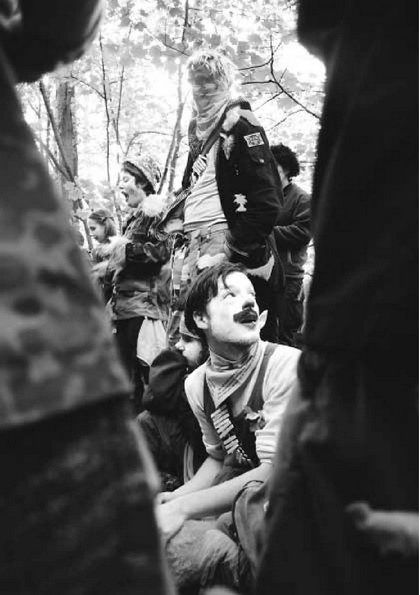
By the end of the tour we had trained over 200 people of all ages and backgrounds, a number of whom were not activists. Many trainees set up their own clown gaggles when we left, in preparation for the G8 and continued to work together afterwards.
For those of us involved in the tour, we saw it as effective a political and pedagogic tool as the actions at the G8. By using popular forms of culture in public spaces we attempted to make our ideas and values visible, attractive, and hopefully irresistible! We felt that turning up in the middle of a city with free food, showing films and putting on performances that glorify civil disobedience, was a strategy that challenges a system which works so hard on demonising us and pushing us to the margins. We created an event that clearly spoke of the pleasure of resistance but somehow fell outside people’s expectations of what radical politics looked or felt like. We looked like the circus coming to town, but were clearly more about subversion than entertainment. By blurring the boundaries between culture and resistance we were able to engage and touch people who might otherwise not have got involved in radical resistance to the G8.
DAYS OF DISSENT
One of the worst mistakes any revolution can make is to become boring. It leads to rituals as opposed to games, cults as opposed to communities and the denial of human rights as opposed to freedom.
Abbie Hoffman, Museum of the Streets
We arrived in Edinburgh completely shattered and the thought of a week of actions ahead of us felt like an almost impossible task. But our spirits were completely turned around when we saw over 160 beautiful rebel clowns converging on a small car park in Edinburgh for the first clown council on the morning of the Make Poverty History march.
A briefing booklet had been sent out to the clown gaggles across the country, which explained details of the framework of mobilisations organised by Dissent!, and described the structures of spokescouncils that we would use to plan and organise the actions.
From across the country and abroad, rebel clowns converged, dressed in the most extraordinary costumes, all different and yet all united by the identity of the rebel clown. This sense of unity within diversity amongst the clowns was one of the most effective aspects of CIRCA. We all shared a common language that we had learnt during the trainings, including various manoeuvring tactics, games and marching. At any point during an action someone could call out ‘let’s fish’, say, and everyone would know exactly what kind of manoeuvre to do. Such a strong sense of unity is often hard to get within autonomous movements with such healthy diversity and difference. But feeling part of an army, sharing aspects of uniform and language, whilst at the same time acting autonomously in gaggles and having our own very particular clown characters, gave us a strength and sense of solidarity that was extremely rare and valuable.
The first spokescouncil, and many to follow, was inspiring. For many of us this was the first time we had experienced this profoundly democratic yet difficult way of making decisions. We ended the first council with a huge group hug and formed up ready to march in military rank and file through Edinburgh. In that magical moment all the trials and tribulations of the gruelling tour faded into the background, as a sea of rebel clowns flooded the streets ready for a week of resistance to the G8.
It was to be a week which saw so many beautiful acts of rebel clowning. There was the clown drawing smiley faces on police riot shields with lipstick and then kissing them with her bright pink lips. There were the cops who had encircled the black bloc, unable to keep straight faces as a small group of clowns mockingly sang ‘One banana, two banana, three banana, four…’ to them. There were the dozen bright coloured clowns moving in unison through the kneehigh green barley as the fences were being pulled down. There was the surreal moment when 70 bleary-eyed clowns woke up at 5am in a real bright yellow castle, 20-minutes’ walk from Gleneagles, that had been magically and mysteriously provided for them as accommodation for the eve of blockades. There was the moment of ecstatic joy as a large determined clown battalion marched straight through a line of confused riot cops whilst chanting ‘Love and respect!’ and ran onto the A9. And there was the moment that we began with, on the bridge, when for a few seconds the police forgot which side they were on.
Published in the book "Shut them down!" by Dissent! and Autonomedia in December, 2005 under the Creative Commons Attribution Non-commercial ShareAlike License.
- CIRCA organises itself in small groups based on affinity and/or location called ‘gaggles’
- The Backwards Intelligence Team (B.I.T.) was set up by people who had trained with CIRCA. B.I.T. is a fantastic parody of the Forward Intelligence Team, a police surveillance group that monitors British street activists with banks of intimidating cameras.
- ‘You’re a bunch of losers, Geldof tells violent protesters’, Daily Telegraph, July 6 2005.
- See communique number 1, www.clownarmy.org
- For more on protest and the carnivalesque see Notes from Nowhere (eds.) We Are Everywhere: The irresistible rise of global anticapitalism (London/New York: Verso, 2002), pp. 173–183.
- This point was made by Starhawk during her extraordinary Earth Activists Training Course, see www.earthactivisttraining.org
- Policing in Scotland during the G8 was a striking example of this very British approach: it was generally really ‘hands-off’. The emphasis seems to have been put on PR and communication, with the most obvious set-up for the media in Auchterarder near the fence (where a huge field of barley became the scene for confrontational games between cops and protesters pulling fences down just under judiciously placed cranes where TV crews were coincidentally waiting for their usual image of ‘violence’).
- Of course this also applies to non-activists, as it is this very control of emotions that enables capitalism to get away with so much violence and injustice.
- See www.labofii.net
- There were discussions with the popular education collective Trapese on whether we should tour together or as separate units, as they too were planning what was to become a mammoth road show to raise awareness about the G8 and the Dissent! network. In the end we decided that rather than centralise our resources, doing more than one tour would be politically more effective, both reaching more people and giving the impression that a lot of different groups were preparing for the G8. In the end Trapese, Lab of ii and SchNEWS all did separate tours and during the Lab tour it was inspiring for us to imagine all these radical collectives crisscrossing the country.
- The lab produced a DVD, 13 Experiments in Hope, that we distributed on the tour. It includes a video of prayers to products and is viewable at http://www.labofii.net/tour05/dvd/watch/
- The caravan set-up was made in collaboration with Birmingham-based www.A2RT.org and is now a resource available to groups who would like to borrow it. Contact john@labofii.net for details.
